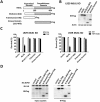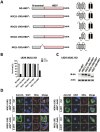Translocation of mixed lineage kinase domain-like protein to plasma membrane leads to necrotic cell death
- PMID: 24366341
- PMCID: PMC3879712
- DOI: 10.1038/cr.2013.171
Translocation of mixed lineage kinase domain-like protein to plasma membrane leads to necrotic cell death
Abstract
Mixed lineage kinase domain-like protein (MLKL) was identified to function downstream of receptor interacting protein 3 (RIP3) in tumor necrosis factor-α (TNF)-induced necrosis (also called necroptosis). However, how MLKL functions to mediate necroptosis is unknown. By reconstitution of MLKL function in MLKL-knockout cells, we showed that the N-terminus of MLKL is required for its function in necroptosis. The oligomerization of MLKL in TNF-treated cells is essential for necroptosis, as artificially forcing MLKL together by using the hormone-binding domain (HBD*) triggers necroptosis. Notably, forcing together the N-terminal domain (ND) but not the C-terminal kinase domain of MLKL causes necroptosis. Further deletion analysis showed that the four-α-helix bundle of MLKL (1-130 amino acids) is sufficient to trigger necroptosis. Both the HBD*-mediated and TNF-induced complexes of MLKL(ND) or MLKL are tetramers, and translocation of these complexes to lipid rafts of the plasma membrane precedes cell death. The homo-oligomerization is required for MLKL translocation and the signal sequence for plasma membrane location is located in the junction of the first and second α-helices of MLKL. The plasma membrane translocation of MLKL or MLKL(ND) leads to sodium influx, and depletion of sodium from the cell culture medium inhibits necroptosis. All of the above phenomena were not seen in apoptosis. Thus, the MLKL oligomerization leads to translocation of MLKL to lipid rafts of plasma membrane, and the plasma membrane MLKL complex acts either by itself or via other proteins to increase the sodium influx, which increases osmotic pressure, eventually leading to membrane rupture.
Figures








Similar articles
-
Plasma membrane translocation of trimerized MLKL protein is required for TNF-induced necroptosis.Nat Cell Biol. 2014 Jan;16(1):55-65. doi: 10.1038/ncb2883. Epub 2013 Dec 8. Nat Cell Biol. 2014. PMID: 24316671 Free PMC article.
-
PI3K mediates tumor necrosis factor induced-necroptosis through initiating RIP1-RIP3-MLKL signaling pathway activation.Cytokine. 2020 May;129:155046. doi: 10.1016/j.cyto.2020.155046. Epub 2020 Feb 28. Cytokine. 2020. PMID: 32114297
-
Hsp90 modulates the stability of MLKL and is required for TNF-induced necroptosis.Cell Death Dis. 2016 Feb 11;7(2):e2089. doi: 10.1038/cddis.2015.390. Cell Death Dis. 2016. PMID: 26866270 Free PMC article.
-
Viral-induced neuronal necroptosis: Detrimental to brain function and regulation by necroptosis inhibitors.Biochem Pharmacol. 2023 Jul;213:115591. doi: 10.1016/j.bcp.2023.115591. Epub 2023 May 16. Biochem Pharmacol. 2023. PMID: 37196683 Review.
-
Necrosome core machinery: MLKL.Cell Mol Life Sci. 2016 Jun;73(11-12):2153-63. doi: 10.1007/s00018-016-2190-5. Epub 2016 Apr 5. Cell Mol Life Sci. 2016. PMID: 27048809 Free PMC article. Review.
Cited by
-
OTUB1 prevents lethal hepatocyte necroptosis through stabilization of c-IAP1 during murine liver inflammation.Cell Death Differ. 2021 Jul;28(7):2257-2275. doi: 10.1038/s41418-021-00752-9. Epub 2021 Mar 12. Cell Death Differ. 2021. PMID: 33712742 Free PMC article.
-
Necroptosis: A new way of dying?Cancer Biol Ther. 2016 Sep;17(9):899-910. doi: 10.1080/15384047.2016.1210732. Epub 2016 Jul 19. Cancer Biol Ther. 2016. PMID: 27434654 Free PMC article. Review.
-
3-BrPA eliminates human bladder cancer cells with highly oncogenic signatures via engagement of specific death programs and perturbation of multiple signaling and metabolic determinants.Mol Cancer. 2015 Jul 22;14:135. doi: 10.1186/s12943-015-0399-9. Mol Cancer. 2015. PMID: 26198749 Free PMC article.
-
Electrophysiologist shows a cation channel function of MLKL.Cell Res. 2016 Jun;26(6):643-4. doi: 10.1038/cr.2016.64. Epub 2016 May 27. Cell Res. 2016. PMID: 27229313 Free PMC article.
-
Characterization of RIPK3-mediated phosphorylation of the activation loop of MLKL during necroptosis.Cell Death Differ. 2016 Jan;23(1):76-88. doi: 10.1038/cdd.2015.70. Epub 2015 May 29. Cell Death Differ. 2016. PMID: 26024392 Free PMC article.
References
-
- Laster SM, Wood JG, Gooding LR. Tumor necrosis factor can induce both apoptic and necrotic forms of cell lysis. J Immunol. 1988;141:2629–2634. - PubMed
-
- Vandenabeele P, Galluzzi L, Vanden Berghe T, Kroemer G. Molecular mechanisms of necroptosis: an ordered cellular explosion. Nat Rev Mol Cell Biol. 2010;11:700–714. - PubMed
-
- Degterev A, Huang Z, Boyce M, et al. Chemical inhibitor of nonapoptotic cell death with therapeutic potential for ischemic brain injury. Nat Chem Biol. 2005;1:112–119. - PubMed
-
- Haas TL, Emmerich CH, Gerlach B, et al. Recruitment of the linear ubiquitin chain assembly complex stabilizes the TNF-R1 signaling complex and is required for TNF-mediated gene induction. Mol Cell. 2009;36:831–844. - PubMed
Publication types
MeSH terms
Substances
LinkOut - more resources
Full Text Sources
Other Literature Sources
Miscellaneous

